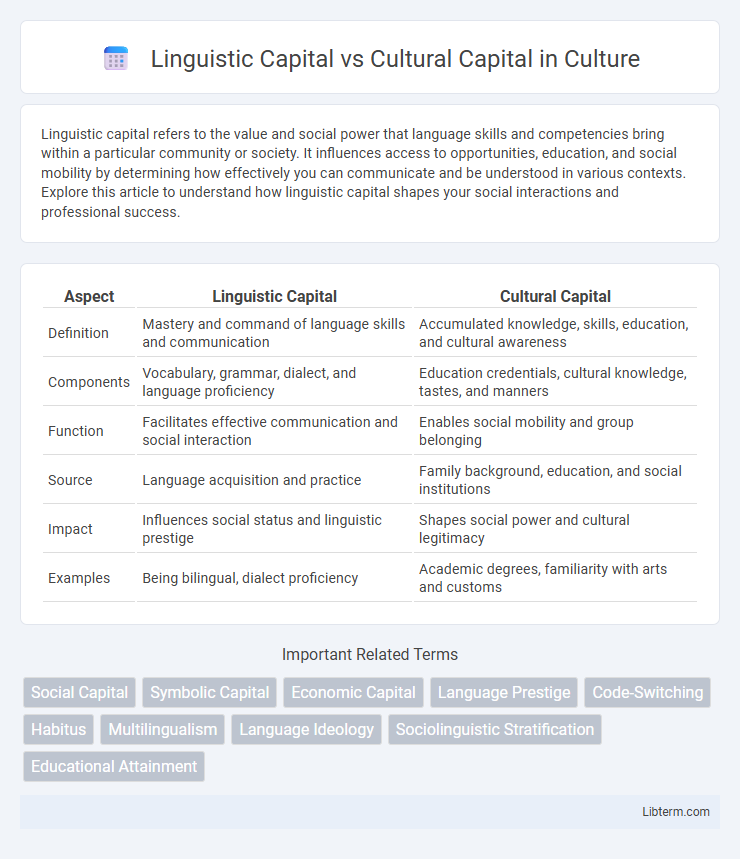Linguistic capital refers to the value and social power that language skills and competencies bring within a particular community or society. It influences access to opportunities, education, and social mobility by determining how effectively you can communicate and be understood in various contexts. Explore this article to understand how linguistic capital shapes your social interactions and professional success.
Table of Comparison
| Aspect | Linguistic Capital | Cultural Capital |
|---|---|---|
| Definition | Mastery and command of language skills and communication | Accumulated knowledge, skills, education, and cultural awareness |
| Components | Vocabulary, grammar, dialect, and language proficiency | Education credentials, cultural knowledge, tastes, and manners |
| Function | Facilitates effective communication and social interaction | Enables social mobility and group belonging |
| Source | Language acquisition and practice | Family background, education, and social institutions |
| Impact | Influences social status and linguistic prestige | Shapes social power and cultural legitimacy |
| Examples | Being bilingual, dialect proficiency | Academic degrees, familiarity with arts and customs |
Understanding Linguistic Capital
Linguistic capital refers to the mastery and use of language skills that provide social and economic advantages within a given society. It includes proficiency in prestigious dialects, literacy levels, and communicative competence that enable individuals to access better educational and professional opportunities. Understanding linguistic capital involves recognizing how language functions as a resource that can enhance social mobility and influence power dynamics in various cultural contexts.
Defining Cultural Capital
Cultural capital refers to the non-financial social assets that promote social mobility, including education, intellect, style of speech, dress, or physical appearance. It encompasses knowledge, skills, and cultural competencies that individuals acquire through family upbringing and education, which influence their access to social and economic opportunities. Unlike linguistic capital, which specifically involves proficiency and mastery of language, cultural capital broadly includes various cultural practices and behaviors valued by society.
Key Differences Between Linguistic and Cultural Capital
Linguistic capital refers to the mastery and use of language skills, including vocabulary, grammar, and accent, which influence communication and social mobility. Cultural capital encompasses a broader range of non-economic assets such as education, style, mannerisms, and knowledge that confer social advantage and status. The key difference lies in linguistic capital being language-specific, while cultural capital includes diverse cultural competencies and institutionalized knowledge beyond language proficiency.
The Role of Language in Social Mobility
Linguistic capital, defined as proficiency and mastery of dominant languages and dialects, significantly influences an individual's social mobility by enhancing access to education and employment opportunities within elite social networks. Cultural capital encompasses a broader spectrum, including language, manners, customs, and credentials, which collectively reinforce social stratification and privilege. The ability to navigate and command prestigious language forms acts as a critical tool in acquiring cultural capital, thereby facilitating upward social mobility and integration into higher socioeconomic classes.
How Culture Influences Access to Opportunities
Linguistic capital, defined by proficiency in dominant languages, heavily influences access to educational and professional opportunities by enabling smoother communication and comprehension within societal institutions. Cultural capital encompasses the knowledge, behaviors, and skills acquired through cultural exposure, shaping one's ability to navigate social structures and access elite networks. Together, these forms of capital determine the degree to which individuals benefit from cultural norms, impacting access to resources, social mobility, and economic success.
Educational Impacts of Linguistic and Cultural Capital
Linguistic capital, defined by proficiency and mastery of dominant languages, directly enhances educational outcomes by improving access to curriculum and academic resources. Cultural capital, encompassing knowledge, behaviors, and skills cultivated through family and social background, shapes students' ability to navigate educational systems, influencing performance and engagement. Together, linguistic and cultural capital determine disparities in academic achievement by affecting communication, comprehension, and integration within educational environments.
Linguistic Capital in Multilingual Societies
Linguistic capital in multilingual societies refers to the ability to fluently communicate in multiple languages, which enhances social mobility and access to resources. It functions as a form of cultural capital by signaling education, social status, and group identity, influencing economic opportunities and social integration. The value of linguistic capital fluctuates based on dominant languages, language policies, and societal attitudes towards bilingualism or multilingualism.
Interconnections Between Language and Culture
Linguistic capital refers to the value and power associated with language proficiency, while cultural capital encompasses knowledge, skills, and education that enable social mobility. The interconnections between language and culture are evident as language acts as a medium for transmitting cultural norms, values, and identity, thereby reinforcing cultural capital. Mastery of dominant languages often enhances access to cultural capital, influencing social status and opportunities within diverse societies.
Societal Implications of Unequal Capital Distribution
Unequal distribution of linguistic capital, which includes proficiency and mastery of dominant languages, profoundly affects access to education, employment, and social mobility, reinforcing existing social hierarchies. Cultural capital, encompassing knowledge, skills, and cultural dispositions inherited from one's social environment, similarly influences individuals' ability to navigate institutions and gain recognition, perpetuating systemic inequalities. Disparities in these forms of capital contribute to the reproduction of social stratification by privileging dominant groups and marginalizing those with less access to prestigious linguistic and cultural resources.
Enhancing Linguistic and Cultural Capital for Equity
Enhancing linguistic and cultural capital fosters equity by valuing diverse language skills and cultural knowledge as assets rather than deficits in education and social settings. Investment in bilingual education, community language programs, and inclusive curricula promotes recognition and validation of multiple linguistic identities. Such strategies empower marginalized groups, improve social mobility, and bridge systemic gaps linked to language and cultural barriers.
Linguistic Capital Infographic

 libterm.com
libterm.com